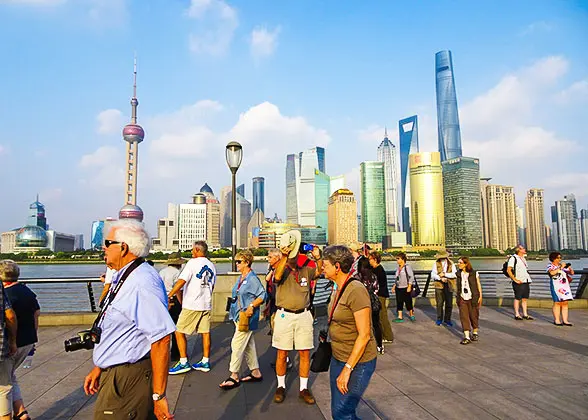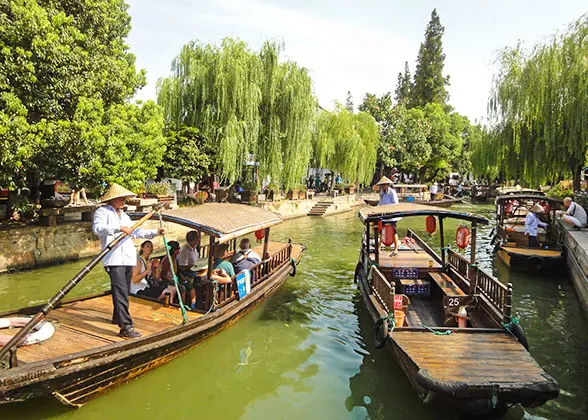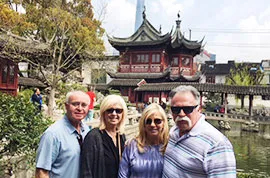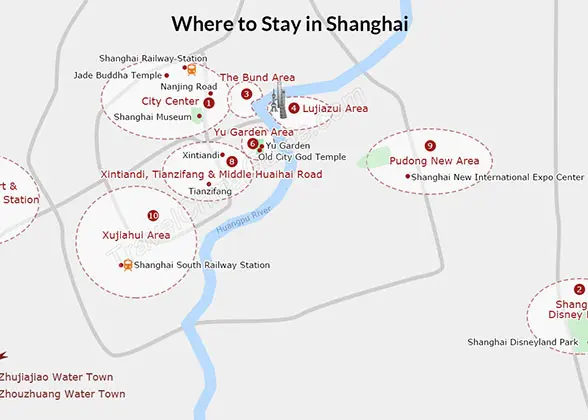15 Free Things to Do in Shanghai
As a metropolitan city, Shanghai is more expensive than other cities in China, so is its travel expense. In spite of this, many attractions in Shanghai are both cost-free and appealing. Below are the 15 free things to do in Shanghai to help tourists plan an affordable trip.
 Read more:
Read more:
 Shanghai Night Tours: Top 7 Night Activities
Shanghai Night Tours: Top 7 Night Activities
 10 Cool Things to Do in Shanghai for Youngsters
10 Cool Things to Do in Shanghai for Youngsters
 Places of Interests in Shanghai: 12 Historical Sites to Explore
Places of Interests in Shanghai: 12 Historical Sites to Explore
1
Have a stroll along the Bund
Located on the west bank of the Huangpu River, the Bund is undoubtedly the most well-known pedestrian zone in this city. As the first recommended free thing to do in Shanghai, taking a walk here enable you to enjoy the beautiful scenery and feel the vitality of this city at the same time. From south to north, you can see many exotic buildings on your left and the flowing Huangpu River on your right. Across the Huangpu River, you can view many skyscrapers. The night view is especially beautiful with the colorful neon lights glowing.
2
Hang out along the Nanjing Road
Nanjing Road is the most prosperous commercial street in Shanghai since the early 1920s. Tourists can still feel its lingering charm upon seeing the western-style buildings on the two sides as well as the Dangdang tram on the street. But don’t forget that the Nanjing Road is also a trendy place. When you take a walk here, you will be surprised by the delicately designed street lamps, flower beds, telephone booths and the imaginative sculptures along the way. Lots of benches are available for tourists to have a rest at any time.
3
Go for a walk at Lujiazui
Lujiazui area also nestles upon the Huangpu River, facing the Bund, and it is known as an international financial center. If the Bund features exotic atmosphere, Lujiazui is a microcosm of this bustling modern city. Many skyscrapers at Lujiazui are the landmarks of Shanghai, including the Oriental Pearl Tower, Jin Mao Tower and Shanghai World Financial Center. Tourists can loiter about at the Lujiazui Central Greenland amid these buildings. Moreover, when the lights are full on at night, you will be amazed by the prosperity of this metropolitan city. Of course, if you would like to pay extra to get to the observation desks on top floors of these high rises, the bird’s eye view is even more fantastic.
This free thing to do in Shanghai can let you not only appreciate cultural relics, but also acquire the knowledge about the profound Chinese history. In the Shanghai Museum, tourists are able to enjoy a visual feast of China’s ancient bronzeware, sculpture, coinage, porcelain, jade ware, calligraphy and painting. There are also theme halls to display the furniture in the Ming and Qing Dynasties (1368-1911) as well as the handicrafts of Chinese ethnic minorities. Shanghai Museum doesn’t charge for entry ticket and opens from 9 a.m. to 5 p.m. from Tue. to Sun. Remember that tourists are not allowed to enter the museum after 4 p.m.
The People’s Park is in downtown Shanghai and enjoys the name of the “City’s Lung” because of the lush vegetation. What’s more, it can be the best place for you to observe the natives’ life. Retired people usually practice singing or dancing and exercise here. At the weekend, the marriage market at Shanghai People’s Park is a unique scene, when old parents become matchmakers to advertise their unmarried son or daughter by posters. Of course, you can simply have a walk or jog here. The fresh air will greatly relax your mind.
People often compare the Zhujiajiao Water Town to a pearl inlaid between the mountain and the lake. Together with the bridges, rivers and quaint buildings, this attraction can best satisfy your curiosity about how the water town looks like in southern China. Tourists can visit the Fangsheng Bridge, which is the largest stone arch bridge with five arches in Shanghai. Pay attention that this water town doesn’t charge admission fee, but some temples and activities inside, such as rowing a boat, need you to pay.
 Book a Zhujiajiao Water Town ticket
Book a Zhujiajiao Water Town ticket
Visiting Xintiandi is one of the most popular free things to do in Shanghai among young people. Xintiandi is rebuilt on the basis of Shikumen Residences in Shanghai, where one can appreciate the typical Shanghai residences in early 20th century combining southern China style and western style. Strolling in Xintiandi, you may feel like strolling in the early 20th century’s Shanghai. Inside, these architecture have been redesigned into galleries, clothes shops, antique stores, restaurants, cafés and bars, etc. Xintiandi is not walled and anyone can enter for free.
Similar to Xintiandi, Tianzifang is also a block of Shikumen residences allowing free entry. But with more alleys, it really likes a labyrinth. In addition to appreciating the Shikemen residences, Tianzifang is a great place to dip in the artsy atmosphere of Shanghai, for most of the residences here have been used as stores and workshops ran by independent artists or craftsmen. When roaming here, you can find not only old-school glasses or music boxes but also the clothes and novelties in vogue. Also, open-air café, gallery and teahouse in Tianzifang can make you linger here all day long. If you are hungry, there are many restaurants for you to try fusion foods. Some Shanghainese still live here, so you can also have a glimpse of their daily life.
The 825m (902yd) long east-west Shanghai Old Street will bring you back to the Ming and Qing Dynasties (1368-1911). Pay attention to the buildings here because they still retain the traditional designs such as the lattice window, quaint banister, up-curling eave and the wall with corbel step. Moreover, this street gathers many century-old stores, through which tourist can vividly experience the life of ancient people. Popular ones are the Tonghanchun Pharmacy, Laotongsheng Cigarette & Liquor Store, Wuliangcai Glasses Store, Wanyouquan Meat Store, and so on!
Standing on the Waibaidu Bridge over the junction of Suzhou Creek and Huangpu River, people can see the traditional alleys on one side and the modern buildings on the other side. Such a view best represents the development of this international city. At night, when the lights are all glistening, the outline of the People’s Heroes Monument, the exotic buildings on the Bund and the skyscrapers in Pudong can’t be clearer. No wonder this scenic spot is often seen in the Shanghai films and now becomes a landmark and one of the top free things to do in Shanghai.
11
Duolun Road
Duolun Road is famous for being the residential area for many influential writers, overseas returnees and people from abroad in the last century. Tourists can still feel the lingering literary charm here upon seeing the western-style villas built with red or blue bricks. Some private galleries and museums along the Duolun Road can show you interesting collections, for example the Shanghai newspapers, the western clocks and ancient coins.
In the China Art Museum, tourists needn’t pay the admission fee and are able to see the shadow puppet show, know more about Shanghai dialect and appreciate many Chinese paintings and calligraphies. Treasures from other countries are also displayed here from time to time. Though it is a free thing to do in Shanghai to visit the China Art Museum, most tourists still choose to pay CNY20 to get to the top floor and appreciate the painting “Along the River during the Qingming Festival”. The reason is that the original painting is a national treasure and the China Art Museum adopts multimedia technology to make every figure on it come alive.
13
Disneytown
Many tourists will come to Shanghai and directly go to the Disneyland Park, but few know that outside the Disneyland Park there is a Disneytown allowing free entry but with less tourists. Tourists will be greeted by the huge toy figures of Donald Duck and Mickey Mouse, etc. Boys can have fun at the Lego Store and girls can’t stop taking photos when standing on the pink ladders or in front of the colorful wall. What’s more, people can enjoy either the vigor of the music band, or the serenity when wandering along the Wishing Lake.
14
Thames Town
As the name suggests, the Thames Town in Shanghai imitates the British architectural style. Tourists will feel like strolling in an exotic town when seeing the Gothic church, Victorian balcony, castle, fountain, café and art gallery. Gathering a cluster of creative industries, Thames Town boasts the cost-free Songjiang Art Museum, Zhongshuge, which is the most beautiful book store in Shanghai, and various displays for sculptures, photos, paper-cuttings and calligraphies, etc.
With a history of nearly 1,100 years, Qibao Ancient Town is like other water towns in China lined with traditional style buildings, twisty watercourses, exquisite bridges, stone paved roads, etc. It is the nearest water town to downtown Shanghai with the distance of only 20km (13mi) and allows free entry, hence one of the popular free things to do in Shanghai. But some attractions inside the town may require a visit fee. People in ancient times liked watching cricket fighting, and now you can experience their hobby in the Qibao Cricket Museum. Adult tourists can also try their beverage in the Qibao Liquor Store. Gourmets can taste the sticky rice cake and the meat pickled in liquor here. Other buildings like the Qiaobao Pawnshop and the Mr. Zhou’s Miniature Statue Museum are also good places to sample the folk culture in ancient Shanghai.
You May Like
- Last updated on Aug. 13, 2025 by Demi Li -



